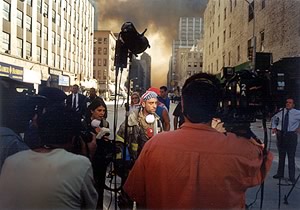All I had in mind, after my arrival, was my fear of losing the immediate impressions I had absorbed of New York City after the attack. It was not easy to look at Manhattan for the last time from a plane during take-off, as people peered through the aircraft windows during a bleeding sunset, in search of that wound they could not see in person but had become so attracted to from the moment the twin towers collapsed. This was the site that was now evocatively titled "ground zero", as if the entire purpose of the disaster was to raise a wealth of associations about the collapse of meanings, truths and, especially, presumptions about reality in order to command us to start everything again from scratch. As I joined many other passengers in trying to look out of the window from an aisle seat, the plane banked sharply, causing one wing to rise up, thus obliterating my view in a sudden manner that made me aware of my own vulnerability in the plane that was dimly lit by hundreds of small television screens, which repeated the same image ad infinitum on the back of all the passengers" seats and, thus, created the specter effect that there was no single stable source and that reality was ephemeral.
Having stood relatively close to the twin-towers and witnessed their fall along with many other curious New Yorkers, who were so adept at running out into the streets with their cameras, I realized that having been there did not necessarily imply that I had the advantage of seeing it any better than those millions of people who did so on the television screen. The fall of the World Trade Center had shaken my entire foundations in witnessing a live event; of looking through a camera and recording reality; and still worse, the speed with which I had adapted my mind to the absence of the towers in the skyline worried me. For an entire day people had only referred to the fall of the towers as an architectural event and in total denial of the fact that so many people had died there. The sight of the waiting empty ambulances, the immediate absence of wounded people or dead bodies, the lack of hysteria and the excellent weather conditions, which outlined the buildings so clearly against the skyline, caused this immense spectacle to be hyper-real and to be regarded and described in cinematic terms by the first witnesses who were interviewed on television.
Only towards nightfall, after spending more than seven hours in the area,
and having witnessed building number seven collapse as well, did I reach
City Hall and realize the terrible implications of this tragedy: it was
the sound of hammers, held in the hands of young volunteers, that restored
the human scale to this Cecil B. De Mille epic and made it plausible to
grasp that thousands of people died. The volunteers were bent over the
sidewalk, preparing makeshift wooden stretchers by hammering nails into
planks of wood. As a photographer, this provided me with a strange realization
of the importance of sound and the diminishing ability of images to provide
the actual emotional experience. It also gave pause to thought that if
anyone ever recreates this disaster in a film they should consider the
following factor: the most tragic moment of the beginning of the 21st
century took place silently, as the cameras were unable to capture clearly
the sound of the falling towers —no death scene and its aftermath
has ever been witnessed by so many people, from such a rich variety of
view points in such silence, and the only loud sounds began much later
when the construction and demolition machinery arrived.
